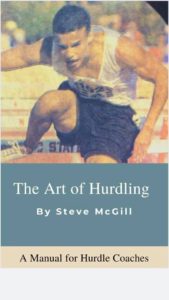February 4, 2020
So, I wrote a book. A book that has been a long time coming. It’s called The Art of Hurdling: A Manual for Hurdle Coaches. It’s available on Amazon as an eBook now, and a print version will be available soon. In this book, I explain the methods and approach I have used over the past 25 years to develop hurdlers. The title of the book lets you know what the book is about—the importance of emphasizing hurdling as art form, and of teaching hurdling in such a way that allows for fluid, rhythmic motion. My philosophy is, if you focus on mastering the art form, fast times will happen naturally, and progress will be continual. But if you focus on chasing fast times and racing against the competition, you’ll never master the art form, and you’ll therefore never discover your true potential.

Although I am artistic and love to pursue artistic endeavors, and although I take an artistic approach to everything I do, I’m also a very practical person, and I value practicality very highly. So, when it comes to drills and workouts and training strategies, whatever it is we’re doing has to work. And it has to work for us. In this book, I hone in on the methods I’ve used over the years that have worked for my hurdlers time and time again. I know that an athlete who is willing to put in the work is going to progress significantly by following the progression of sprinting and hurdling drills that I use, by sticking with the workout plans that I design, and by thinking outside the box of victory and defeat. The hurdler who approaches hurdling as a quest to master the art form will always discover new ways to improve. And, for such a hurdler, the greatest gratification comes not from defeating opponents or setting personal bests, but from the feeling that comes with running over hurdles free of doubts and inhibitions.
So, if you’re an instant gratification person, this book is not for you. But if you’re in it for the long haul, then this book will prove beneficial. To me, the art of coaching is all about having a plan, but also being able to come up with new ideas in the moment, and to pursue those ideas without fear of failure. A coach needs to be logical and practical, but also needs to be bold and daring. And he or she needs to know when it’s best to be practical, and when it’s best to take a chance. This book is not for coaches who want to copy and paste workouts into their own training program. It is for those who are looking to satisfy their natural curiosity and expand the possibilities of what they can do in coaching their hurdlers.
In this book, you will learn a lot of basic things regarding technique and rhythm that many hurdlers, even at the elite level, don’t do efficiently. I would estimate that, at the youth and high school levels, about 95% of the hurdlers I see don’t hurdle efficiently. At the collegiate level it’s not much better because so many hurdlers take their flaws with them to college and try to compensate by getting stronger and faster. Even at the professional level, I’d say that at least 50% of the hurdlers could easily drop time by correcting a simple technical flaw or two. If you don’t master the basics at a young age, bad habits become ingrained, and as you get older, it becomes increasingly more difficult to break such habits.
By reading this book and applying its principles, coaches can know how to teach the basics properly,; in addition, experienced hurdlers with flaws can be taught how to break the bad habits and replace them with good ones. My message to hurdlers who read this book is simple: if you commit yourself to trusting the process of mastering the art form, you won’t need to see the time on the timing system to validate all the hard work you’ve put in; the feeling you have during a race, and even during a practice rep, will inform you that there is nothing in the world more wonderful and joyous than running the hurdles. And that’s what will keep you coming back.
